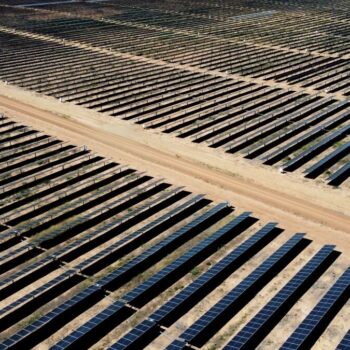The right mix of political, technological and economic instruments is essential if the challenge of irreversible climate-change is to be met, says Tom Burke of E3G, in an article published today by Open Democracy.
Since the publication of the Stern report on the economics of climate change on 30 October 2006, several things about climate change have come into much sharper focus. We know what the world has to do to avoid the risk of fundamentally undermining our prosperity and security. We know how to do it. We know we can afford the cost. We have the technology and the capital we need to guarantee climate security. What we do not know is how to mobilise that technology and capital on the scale and with the urgency required by the inexorable laws of physics, chemistry and biology. In other words: it’s the politics, stupid.
When Kofi Annan addressed the climate-change conference in Nairobi on 15 November, he pointed to “the frightening lack of leadership” from the world’s politicians. There is a yawning gap between what the science of climate change requires if we are to maintain climate security and the pace at which either national or global action is taking place.
The Stern report pointed out that if the concentration of greenhouse gases in the atmosphere doubles from its pre-industrial levels, the odds are even that the rise in global temperature by the end of the 21st century will be some 30C. This is well past the point at which the irreversible melting of the Greenland ice-sheet will have begun, and very near the point at which the Amazon rainforest could begin to collapse. If greenhouse-gas concentrations continue to rise at their current rate, that doubling will occur in less than four decades.
Nicholas Stern’s estimate of the possible cost to the economy of damage on this scale was a loss of 5%- 20% of global GDP: enough, he pointed out, to “derail the economy”. Strangely, the response of many economists was to criticise his estimate simply because it was out of line with the 2%-3% more common in literature on climate economics. Many scientists thought he had erred in the other direction and greatly underestimated the actual costs of a rapidly changing climate.
The cost of failure
This is one indication of a wider trend: that there is little by way of a systematic conversation between the scientific and economic communities on climate change and much of the economic analysis remains poorly informed by the science.
A single example will serve to illustrate just how difficult this is. We know that the rising concentration of greenhouse gases is affecting the temperature, salinity and pH of the oceans. We also know that all three factors greatly affect the productivity of marine ecosystems. But our knowledge of marine ecosystems is still so underdeveloped that no one could say with any confidence what this means for the productivity of either coastal or pelagic fisheries, except that no one thinks it is likely to improve it. You have to be very brave to attach a monetary cost to an impact you cannot yet describe.
Stern’s central estimate of the cost of dealing with climate change is 1% of global GDP. In his analysis this means keeping the concentration of greenhouse gases to less than 550 parts per million (ppm) carbon-dioxide equivalent (CO2e). [Carbon dioxide equivalent is the measured concentration of carbon dioxide (currently 380 ppm) plus the warming effect of all the other greenhouse gases expressed as their equivalent in carbon dioxide (currently 45ppm)].
Stern’s 1% figure is actually his best guess from a range of estimates that runs from -2% to +5%. What the actual cost will be is determined crucially by the speed and manner with which we act. If we act soon and intelligently, the cost will be a lot lower than if we act later and clumsily. Furthermore, were governments to act quickly and cleverly, tackling climate change could actually grow the economy.
An arcane debate is likely to rage for some time in the economic literature over whether Stern got his numbers right. This will matter little. The analytic tools economists are bringing to this issue are still so immature that it will be some time before the numbers mean much. The enduring significance of the Stern findings is that the cost of failing to tackle climate change will so vastly outweigh the cost of succeeding that further refinement of the precise difference will be interesting but largely irrelevant to the political choices we must now make.
The most important implication of Stern’s synthesis of the current science of climate change is that the world’s energy system must become carbon neutral by the middle of this century. Currently we add more than 10 billion tonnes of carbon (10GtC) to the atmosphere each year. Most of this – some 7GtC – comes from our energy use, the rest is a product of agriculture and deforestation. The oceans and vegetation absorb approximately the amount of carbon arising from agriculture and deforestation. Since this is effectively impossible to reduce significantly, maintaining climate security leaves us no choice but to eliminate the carbon burden of the energy system.
This presents us with a two-phase problem. In the first phase the priority is a massive technology transition from carbon-intensive to low-carbon technologies for delivering electricity, heating and cooling, and movement in order to drive the carbon out of the energy system very rapidly. The second phase requires us then to keep the carbon out of the economy effectively for ever.
This is no small task. The principal policy tools to accomplish it are setting a price on carbon through the development of carbon markets or the use of taxation; the setting of technology standards for energy technologies; and the creation of incentives for investment in low-carbon technologies. Success will require the use of all three tools, but the mix will vary with time and place.
No turning back
Much faith is currently being placed on putting a price on carbon. While this is undoubtedly essential, the theory offers more than the practice. In part this is due to the particular nature of the climate problem and in part to the difference between the behaviour of economic models and the real world.
The latter point has been convincingly demonstrated by the price of oil since the beginning of the century. If you had entered a tax sufficient to raise the price of oil by 400% into any economic model running in 2000 it would have projected a very rapid and vicious global recession. In fact, when a combination of factors raised the price of oil by 400%, the real economy, to much surprise, continued to grow rapidly. This phenomenon makes it very difficult to advise governments on what price they need to set for carbon in order to achieve a carbon-neutral energy system.
This is where the earlier point about the nature of the climate problem kicks in. Climate change is irreversible, at least on human timescales. Once we pass any given concentration of greenhouse gases we are committed to the climate they drive and whatever consequences for human wellbeing that brings. There is no rewind button. Unlike any other area of government action, policy failure cannot be corrected later.
Relying too heavily on the use of the somewhat brittle tool of a carbon price to deliver climate security would certainly be a triumph of hope over experience. This means we will need to hear a lot more in the coming year of the part that must be played by the other two tools in our toolkit, technology standards and investment incentives.
This article has also been republished by Pakistan’s The News.


